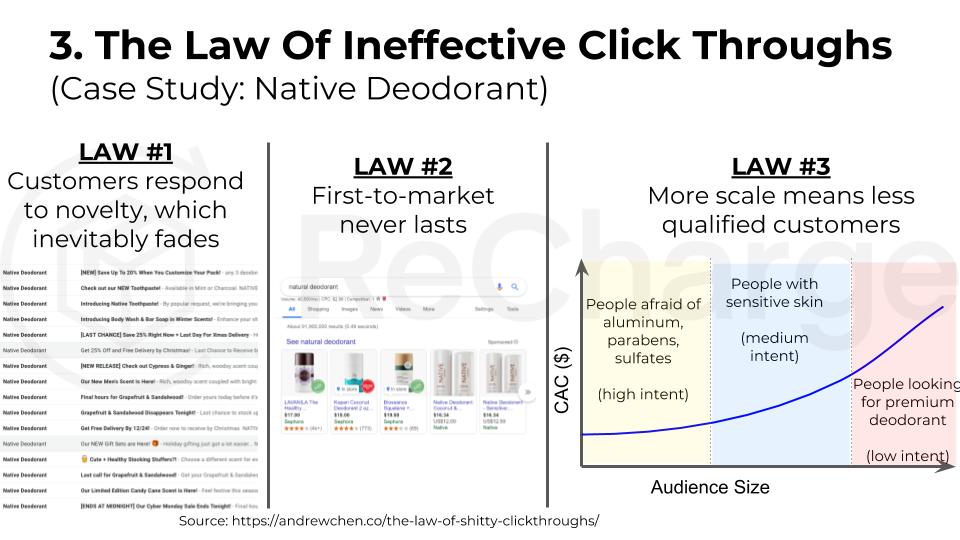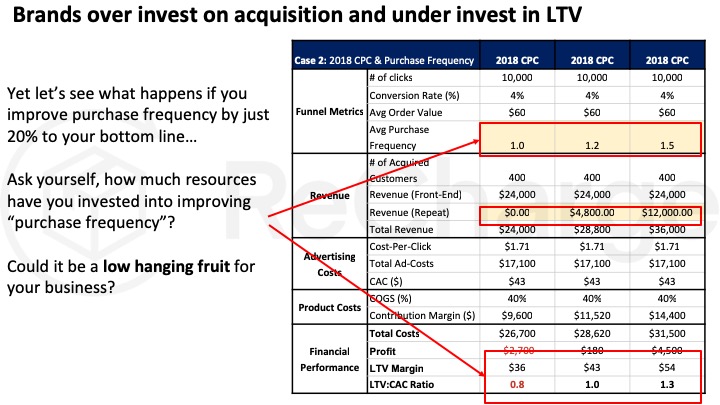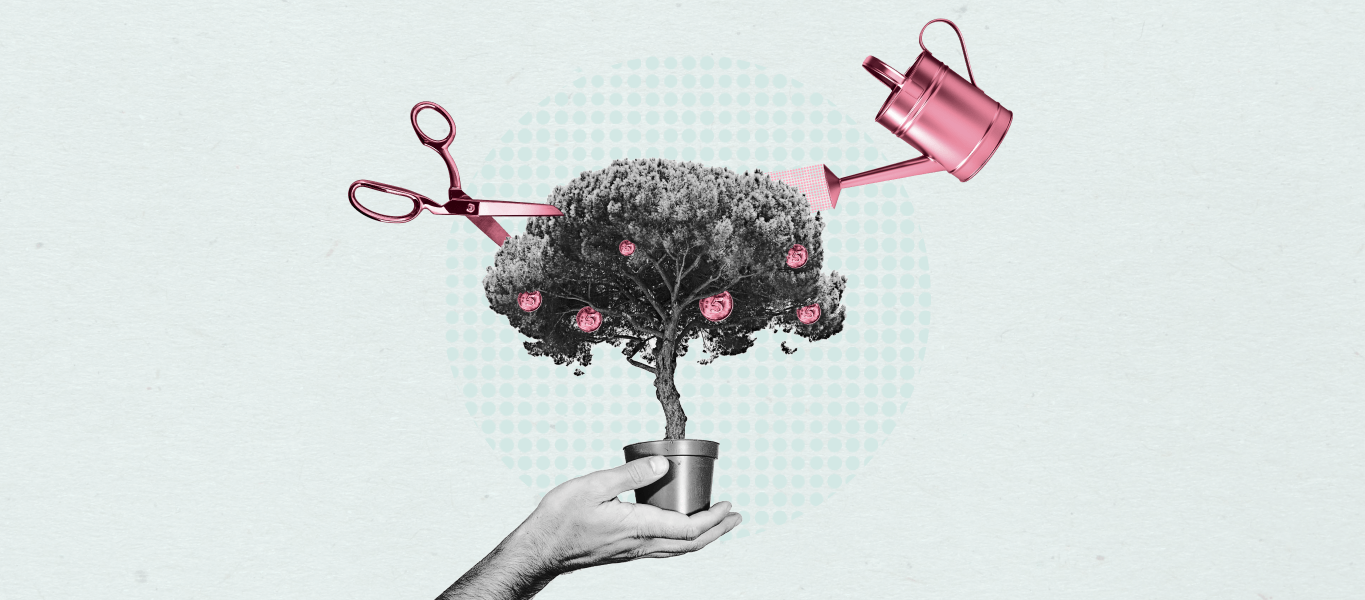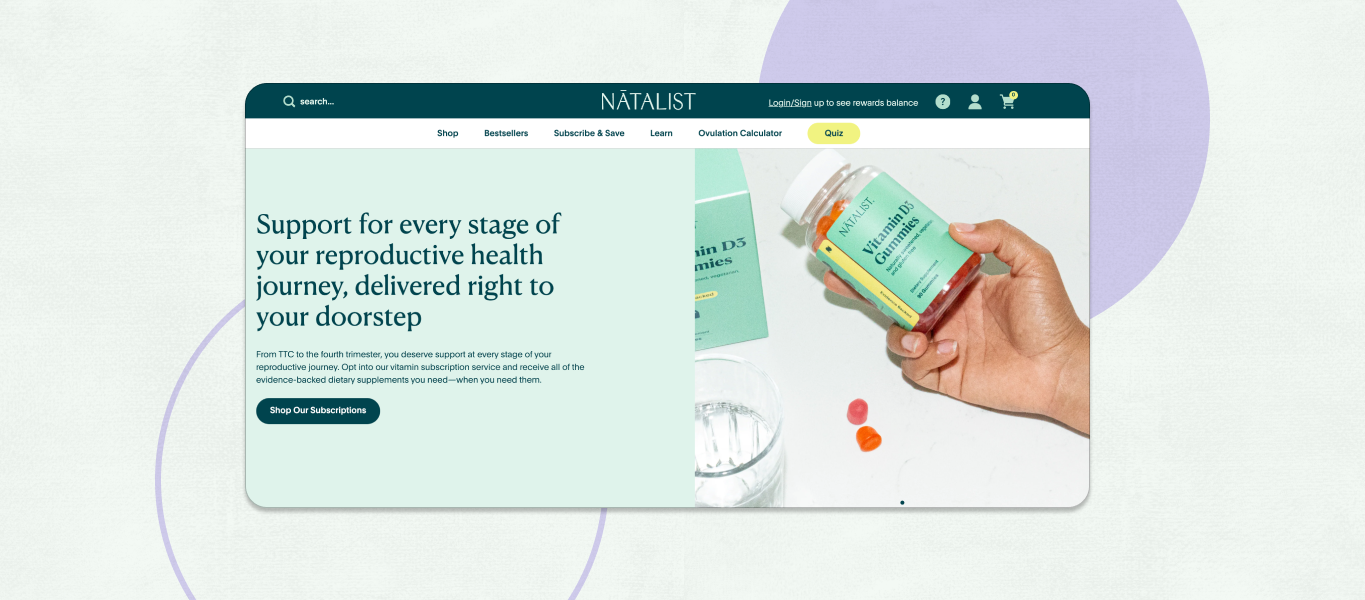It’s getting really expensive to acquire new customers. Up till now, inefficient direct-to-consumer (DTC) startups were able to thrive simply relying on first mover advantages & distribution opportunities provided by Facebook & Google. Improving your LTV:CAC ratio is the key to growing sustainably.
As the “golden era” of DTC startups is over. Only the brands that are able to improve their customer lifetime value (LTV) to customer acquisition cost (CAC) ratios will continue to grow sustainably.
In this article written by Wilson Hung, Director of Growth @ Kettle & Fire and Co-Founder of GetARPU.com, we’ll examine why ad costs are rising so unsustainably, how to mitigate those costs by improving LTV:CAC, and examine high level strategic trends as alternatives to consider for your brand.
Part 1: Why ad costs are rising

Prior to 2014, it was difficult to scale a Digitally Native Vertical Brand (DNVB). However, as the major ad platforms, like social media and search engines, became more advanced with improved attribution and bidding capabilities, so did the opportunity for these online-first brands.
Fast forward to 2015-2016. Entrepreneurs started taking notice of the opportunity and the early adopters of DNVBs were entering the space. This early stage was the “golden period” where DNVBs had access to large consumer markets at very low advertising costs. Advertising via social media and search engines was still in its infancy, giving more visibility to these up and coming brands.
But in 2017-2018, the space started to see the first signs of rising ad costs. The early brands began to saturate their “core consumer groups” and ad costs began to rise. At the same time, competition for the same product categories started to emerge and has resulted in more competition.
In 2019, ecommerce professionals and analysts predicted continuous rising ad costs as brands become over-reliant on paid acquisition and venture money flooding into the space.
Consumer CPG changed at rapid speeds, and the incumbents were struggling to figure out how the response to losing market share from the DNVB startups.

image source: https://www.cbinsights.com/research/circleup-guest-post-product-launch-fallacy-big-cpgs/
As a countermeasure, incumbent CPGs are increasingly outsourcing their R&D by creating startup investment funds. These funds are backed by some of the largest companies in the world with lots of available capital.

This has created an environment where emerging DNVBs have greater access to capital, and 40% of VC dollars go towards Facebook, Google, and Amazon.
“Today’s massive venture-backed advertising, sales, and user acquisition playbook has morphed into one that champions growth at any cost. Startups spend almost 40 cents of every VC dollar on Google, Facebook, and Amazon…fresh tactics go stale in months, and customer acquisition costs keep rising.”
Chamath Palihapitiya, Founder of Social Capital:

On top of new DNVBs having access to capital, there are also more DTC brands being created. This results in higher ad costs due to increased competitive bidding on the same keywords and audiences.
The emergence of new software tools & platforms made it easier and cheaper than ever to launch online brands thus reducing the barrier to entry. Where early brands had to develop their own e-commerce technology stacks, SaaS companies, such as Shopify, Recharge Payments, GetARPU, began to gain steam as they developed solutions to fit the needs of these online-first brands.
There were also emerging debt financing options like Clearbanc and Circleup which made it easier than ever for brands to finance inventory and marketing spend.
And of course, the presence of the major advertising platforms have made it much easier to scale new businesses. Instead of selling a new CPG brand at local farmers markets, entrepreneurs have increased targeting, accuracy, and access to scale at any stage of their business. The digital nature of this process has allowed for the marketing and sales expenses to go toward new customers in new geographic locations, ultimately broadening the reach.

Due to increased competition, brands are now able to take “experience shortcuts” by using tools like AdEspresso to gain visibility into top-performing creatives from competitors, as well as looking at other brands for inspiration on their sales funnel. As consumers begin to see “similar” creatives and landing pages, ad fatigue causes lower performance, which in turn increases the difficulty of acquiring customers.

This phenomenon is nothing new, the effectiveness of marketing channels will continue to decrease as brands scale due to the “Law of Shitty Click Throughs” coined by Andrew Chen.
“Scale effects mostly work against you in paid marketing. The longer your campaigns run, the less effective they become – people start seeing your ads too often.”
Andrew Chen, General Partner at Andreessen Horowitz
So as a DTC brand grows, they saturate the “more affordable” core consumers. To continue growing, the volume eventually comes from the “more expensive” non-core consumer groups. This requires more education to convince these less qualified buyers. More education ultimately means more touch points, which means more clicks that have to be funded by advertisements, which means higher marketing expenses.
A recap on the rise of ad costs.
Ad costs are rising because:
- Increased VC funding resulting in record high digital advertising spend: DNVBs have access to more VC funding than ever before combined with 40% of VC money going into Facebook, Google, and Amazon.
- Increased Competition in the DNVB Landscape: With the emergence of new ecommerce SaaS tools, advertisement platforms, and new financing options, it’s easier than ever to create digital brands.
- Increased Ad Costs Due To The Law Of Ineffective Click Throughs: Marketing efficiency decreases as volume scales due to consumer fatigue, increased brand competition, and access to less qualified consumers.
Part 2: What is the LTV:CAC ratio and why is it important?
The brands that will perform the best in the DTC space are able to improve their customer lifetime value to customer acquisition cost ratio to mitigate the detriment of rising ad costs.
What is the LTV to CAC ratio?

Lifetime value (LTV) is the value of a customer to the brand’s bottom line. And the customer acquisition cost (CAC) is how much the brand pays to acquire a new customer. Thus the LTV:CAC ratio helps understand the leverage a brand has between what the value of a customer is, and the cost to acquire one.
When the LTV:CAC ratio is below 1, the brand is taking a loss to fuel growth. This is unsustainable and will eventually rely on financing opportunities to sustain revenue growth. The problem is as a brand continues to grow, the customers get less qualified, meaning their customer lifetime value will decrease, which in turn, lowers the entire ratio.
Why is LTV:CAC important?

In the model example above, the metrics are fictional but comparable to the average DNVB. Each column represents a different year, from 2016 to 2018, and for simplicity, we will assume the average purchase frequency to be equal to 1.

The only changing variable for each column is the ad-costs, captured as the “Cost Per Click” and based on benchmarks from AdEspresso.

During the “golden era” of DNVBs in 2015-2016, these early brands enjoyed access to cheap ad costs which made their business model see tremendous customer profitability.
In the 2016 example, just on the first purchase alone, the brand was able to be profitable with a LTV:CAC ratio of 2.3. This means the brand is able to immediately reinvest the profits into funding more advertisements resulting in exponential growth.
However starting in 2017, we start to see the consequences of rising ad costs. The brand is still able to be profitable on the first purchase, but barely. This means less profits are able to invest in growth opportunities.

And finally in 2018, the rising ad costs made it such that the brand is now losing money on the first purchase. This ultimately means that the brand must improve efficiency, or rely on projected future income from repeat purchases to fund growth. This puts a strain on cash flow as the brand ventures into a “payback period” user acquisition strategy.
Recapping the LTV:CAC ratio
LTV:CAC is a ratio brands can use to understand the amount of leverage they have to acquire a customer. Since LTV is the total value of a customer to the bottom line, and the CAC is the cost to acquire a customer. The higher the ratio, the more profits the brand can leverage to reinvest into growth (additional advertising, more hires, more R&D, etc). However, the lower the ratio, the less profitable the brand is and sustainability to continue growing the brand. Brands that were typically profitable with high LTV:CAC ratios in 2016 are no longer profitable due to the rise of ad costs.
Part 3: The five trends of high performing ecommerce brands
Improving Efficiency of Customer Acquisition

As demonstrated in Parts 1 & 2, the “golden era” of DNVBs are over. But there’s still a lot of opportunity in the market. Brands are able to mitigate the rising ad costs by either improving CAC efficiency, or by increasing LTV.
Improving CAC efficiency
Trend #1: The best brands will lower CAC by bringing core competencies in-house

Historically, brands were able to outsource core competencies to agencies. However, I predict that the brands that continue to thrive are able to bring in the key skill sets in-house for two main reasons:
Reason #1
The major ad platforms have become so advanced that it has leveled the playing field for media buyers. In the early days, ad agencies focused on in-house ad buying technologies and created an advantage due to opportunities that could only be taken advantage of by agencies.
But now, the Facebook & Google algorithms are so advanced where the skillset barrier is much lower. A common & effective strategy for targeting on Facebook now is “just let Facebook’s algorithm do it’s thing” and hope it produces results. Also due to the popularity of these platforms, it is easier and cheaper than ever to find skilled & talented buyers familiar with these platforms.

An example of this is with day parting. Facebook & Google’s algorithms for the most part could be set on “automatic” without manual intervention. This is where agencies with custom in-house software become more valuable as they can automatically distribute spend to take advantage of inefficient day parting.

Reason #2
Because of the above reasons, the main value of agencies has become more strategic. They drive value by having processes and teams that optimize for ad creatives, testing, and data analysis. However, these are the core competencies that brands should nurture in-house because they are the prerequisite skill sets to the bigger picture: increasing the lifetime value of a customer (more on this in Trend #3). In order to fund the creation of these “core competency functions,” the performance channels need to be taken in-house.
For example, let’s assume a brand spends $200k per month on Facebook and pays a typical 15% of ad-spend fee which equates to $30k each month.
That 15% agency fee could be used to invest in the creation of an internal creative team (e.g head of creative, copywriter, designer). This creative team would initially support only the “Facebook ads” channel because it’s the channel with the highest demand for creatives.
However, over time as the creative team builds up internal skill sets, the brand is able to gain a better understanding of the customer pain points and what value propositions resonate the most. The customer research & learnings are also all retained in-house.
Eventually, the creative team is operating efficiently and showing results improving the effectiveness of Facebook ads due to the improved click throughs. This means the brand can now start expanding the creative team, hiring more copywriters/designers, and adding in additional functions such as videographers.
Now the creative team has more capacity to support other areas of the business by providing ads to “Google Adwords”, creating landing pages, email marketing, and so forth. And since the “learnings” are all retained in one group, an “effectiveness multiplier” is now compounded on all the other areas of the business, thus ultimately driving down the CAC ratio across the entire organization.
The same framework applies to other core competencies such as a testing/CRO team, data team, and a retention team.
Trend #2: The best brands will lower CAC by diversifying channel mix away from Facebook/Instagram & Adwords

Due to rising ad-costs, brands will be forced to look at ways to diversify their user acquisition channels so they aren’t as reliant on Facebook or Google.
Marketing channels come and go (e.g. website ad banners). As one tactic is adopted by the masses, the effectiveness ultimately declines. By the time brands realize their channels are no longer profitable, it’s already too late. The best brands are able to set aside resources for “R&D on new distribution channels” with the goal of creating their own inventory, rather than bidding on it.
“I think what’s going to happen is you’re going to see a lot of the biggest DTC brands are going to have really powerful founders, and that is going to be the differentiation,” Perell said. “If you look at people with reach or people with influence, they start off from day one with way lower customer-acquisition cost and that right there is the delta between failure and success.”
David Perell from AdWeek
This means identifying other companies and platforms your consumers spend time on outside of Facebook or Google. These channels take more time to establish and they’re not as easy as turning on an ad on Facebook, but because the barrier of entry is higher, you get better costs as it’s not widely accessible to the open market.
Examples of brands “creating their own inventory” include:
1) Perfect Keto creating their own podcast (over 1M downloads) for their target consumers. This is a great opportunity to own a valuable “mindshare” of potential customers, and to build relationships with influencers.

2) Dr. Axe investing into Content Marketing & SEO resulting in over 5MM/mo. This has “network effects” by positively impacting paid channels such as FB ads due to larger retargeting audiences.

3) Native Deodorant creating a new SKU just for “referrals” with the “give a free mini deodorant” strategy which has resulted in over 100,000 successful referred customers.

“One common trait that these thriving brands share is their oft-viral, cultivated, loyal following. In the future – brands will begin, not by immediately selling products but by curating an audience first. In 2010, Glossier Founder Emily Weiss launched Into the Gloss. It was then a beauty blog that featured inspiring women across a spectrum of professions, ethnicities, and wealth.”
Web Smith, The Pivot To Tradition (2PM)
There will always be a tradeoff for growth when compared to efficiency. As a brand grows, it is inevitable for CAC’s to continue to rise, so to improve the LTV:CAC ratio, brands must also be able to improve LTV.
Improving lifetime value (LTV)

To illustrate the importance of improving repurchase/retention rates to increase average lifetime value, let’s look at another hypothetical scenario.

In the above example, all columns have the same ad costs based on 2018 rates. Each column also has the same conversion rates, average order values, and contribution margins.

The only thing that changes in this example is the “Average Purchase Frequency” or repeat purchases.

By just increasing the purchase frequency by 20%, what was initially unprofitable is now profitable. Unless brands “pay to re-acquire a customer,” the cost to acquire a customer is only realized once. So all future purchases have improved margins because there are no advertising costs.
The importance of recurring subscriptions
Figuring out how to tie in a recurring subscription model is going to be incredibly important to mitigate the rising ad costs. Fortunately, subscriptions apps such as Recharge makes it easy for DNVBs to tie in a subscription into their business model.
Many of the major DNVBs usually have some sort of “subscription based” model tied into their purchase options. Subscribers have much higher purchase frequencies, and the predictability of annual recurring revenue helps de-risk a “payback period” model for DNVBs. In fact, a single customer can maintain a much higher LTV to CAC ratio, due to the returning nature and future revenue they will generate.
With a lower churn rate, and higher retention rate, subscription customers are more likely to be in it for the long-haul with a brand. The customers added to the subscription model results in a compounding of growth that allows for higher average annual recurring revenue than just one-off purchases allow.

Top Left Corner: Brands that have products that do not fit a subscription based model will typically need to have very high average order values (i.e. Casper) with high margins to scale. Otherwise, these brands will need to rely on non-paid channels such as MVMT focusing on social virality to scale their online business, and creating multiple products to cross-sell to existing customer bases.
Bottom Left Corner: Brands with products that do not fit the subscription based model and lack high average order values typically will have difficulty scaling their business. The vast majority of DNVBs currently fit this category and are typically the “mom & pop” businesses with flat year-to year growth. Brands that are able to survive in this category typically rely mostly on retail distribution (e.g. Primal Kitchen).
Top Right Corner: Brands with products suitable for a recurring subscription, with high average order values and margins are the ones that are best suited to scale a paid media first strategy. These brands have the luxury of having extremely high LTV:CACs which enable unique offers such as free plus shipping or trial based funnels.
Bottom Right Corner: Then there are the brands with natural subscription products, but low average order values. These are the brands that typically require non-paid channels during initial traction, such as Dollar Shave’s viral Youtube Videos, or Harry’s referral campaign. After these brands gain initial traction, they typically will need to raise large amounts of funding to scale paid media because these of long payback periods due to the low average order values. These brands are also heavily incentivized to come up with SKUs specifically for cross-selling to increase the average order values of existing subscribers (i.e. Razors → Shaving Cream).
One of the most difficult roles to hire for is someone qualified to own the “LTV metric”. Where there is an abundance of people who know “Facebook Ads”, there is less expertise surrounding retention & LTV.
“Retention & Growth related roles are incredibly difficult to hire for. The profile of this candidate is weighted towards a data/product skill sets instead of traditional marketing backgrounds. So instead of people with “marketing/business degrees”, we’re looking for people who have traits typical of strong programmers, engineers, investment bankers, or data analysts.”
Markus Karjalainen, Head of Digital @ Foursigmatic
One mistake many brands make is assuming LTV & retention is mostly comprised of “email marketing.” So they hire people with email marketing backgrounds. But in reality, there are many aspects related to improving LTV.
Trend #3: The best brands will increase LTV by assigning an owner to the LTV metric

To improve LTV, there are three metrics brands can increase: Gross Margin, # of Purchases, and the Average Order Values (AOV).

Someone within the company must also own the “gross margin” metric by always improving on margins. Whether if it’s re-negotiating rates with fulfillment partners, or through operational excellence to increase production yields to reduce manufacturing costs, improvements to the Costs Of Goods Sold is one of the biggest drivers to increase LTV.

The other responsibility of the LTV owner is to increase the number of purchases per customer. There are multiple opportunities here, but in general, the biggest levers typically involve custom development projects to improve product/site design. So the best brands are able to manage development & UI/UX resources to increase subscription opt-ins, reduce churn, and increase revenue-per-visitors

Lastly, brands can also improve LTV by increasing average order values. Typically, brands will only optimize for AOVs on the first purchase (e.g. tiered pricing discounts to encourage higher quantity orders).
However, one opportunity many brands miss out on is increasing AOVs on their subscription customers. The customers on a subscription plan are the most engaged & loyal customer base, but very few brands attempt to up-sell/cross-sell other products. One easy way to do this is leveraging the upcoming order notification emails to sell more products to subscribers using tools such as getARPU.com
Trend #4: The best brands will increase LTV by reorganizing the DTC function to optimize for LTV

Once brands are able to assign an owner to the LTV metric, they can now start restructuring the marketing function. The support functions (creative, testing, data) established in Trend #1 are now able to assist the two main teams: Traffic & Monetization Teams.
“In the early stages of a business, it’s natural to have less specialization amongst people on the marketing team. One structure is to have a traffic team and a monetization/LTV team. The former (traffic) focus solely on driving customers in, typically to the website. The monetization and LTV team typically is responsible once someone hits the site. So everything from on-site conversion, upsells, etc. all the way thru back-end monetization and retention.”
This isn’t to say that the teams don’t interact. Obviously, it’s crucial that the traffic team understands what’s being offered on the site, via email, etc. And so it’s helpful if both teams roll up into one person, whether a Director or VP of Marketing who helps to ensure that the teams are coordinating appropriately.
One of the reasons this structure can work, other than creating specific accountability to team members, is that often times, the personalities who thrive at scale in these roles are a bit different.
Traffic folks certainly need to have a measure of creative aptitude, but there’s also an aspect of day trading that comes with this role. Digging into data within a platform, finding openings, pressing where things are good, backing off where they aren’t.
Conversion and retention folks aren’t necessarily the opposite, but more seem to thrive at a different pace. The reality is that working on back-end monetization and seeing the results of a retention campaign takes a lot more time than whether a new creative worked on Facebook.
It’s not about good or bad, just different. And so find a place where each of the team members can add meaningful value, in a role that may be better suited to them, can mean a win for all parties.”
Babak Azad, Prev. SVP Media & Customer Acquisition @ BeachBody
It’s important to note that the two teams must work closely together to identify the channel sources with the highest quality of potential customers. A brand can have a world class retention strategy, but if the traffic team is bringing in low quality customers, the retention will suffer. Thus it’s critical to communicate and set different CAC targets for each channel based on the LTV per channel. This is why it’s so important to improve the data infrastructure, as we’ll discuss in Trend #5.
Trend #5: The best brands will increase LTV by making more accurate decisions informed by data

Brands that are able to improve their data infrastructure will be able to make better decisions informed by data. By understanding the LTV by Channel, brands are able to allocate resources to better quality channels.
“Given that many performance marketers will drive spend when they see good results, the accuracy of a brand’s data infrastructure is very important. I have a client in the health and fitness space that ramped spend from $75K per day to $700K per day in the matter of a week. If their LTV model were wrong, that could be a very costly mistake.”
Babak Azad(Prev. SVP of Media & Customer Acquisition @ Beach Body).
Instead of assigning the same CAC & Return On Ad-Spend targets across all channels, the best brands are able to assign targets that are unique to each channel. This ensures quality channels have sufficient resources while divesting from poor quality channels.

To mitigate rising ad costs, brands will begin to have difficulty to become profitable on the first purchase. This means brands will need to create new CAC targets based on a payback period they are comfortable with. So the brands that have inaccurate or little understanding of their LTV model will ultimately be limited because they’ll be leaving money on the table, or losing more money than anticipated.
“Understand LTV by channel (margin, not simply revenue) is key. But so is knowing what constraints the business is operating under – based on cash flow, business risk, goals, etc., what are the parameters around when you have to breakeven on a new customer. So better understand how that LTV plays out over time (day 0, 1-30, 31-60, etc.) can have a big impact on how you manage paid.”
Babak Azad(Prev. SVP of Media & Customer Acquisition @ Beach Body)

The brands that are able to understand a payback period are then able to create financing strategies to cover the period of “negative cash flow”. And once brands have the data infrastructure to track the payback period, they can start reducing the period by focusing on improving up-sells & cross-sells to increase the value of each customer (e.g. using apps like getarpu.com)
Recapping the five trends of high performing ecommerce brands
The brands that are able to mitigate for rising ad costs will be able to work on the 5 trends of high performing brands:
- Trend #1: Improve sales & marketing efficiency by bringing in core competencies in-house from agencies
- Trend #2: Diversify acquisition channels to non-paid or emerging paid channels
- Trend #3: Assign a owner to the LTV metric to create a cohesive strategy
- Trend #4: Reorganize their marketing teams to optimize for LTV
- Trend #5: Make more accurate decisions informed by data

In summary, the golden days of DTC brands are over due to rising ad costs driven from rising competition. To mitigate for rising ad costs, the brands that are able to thIn summary, the golden days of DTC brands are over due to rising ad costs driven from rising competition. To mitigate for rising ad costs, the brands that are able to thrive will be able to improve their LTV:CAC ratios. These brands are able to improve LTV:CAC by increasing LTV, and also slowing down the rise of CACs with increased efficiency.

Wilson Hung is the Director of Growth @ Kettle & Fire, and the Co-Founder of GetARPU.com. ARPU increases your LTV by making it easy for your subscribers to add one-time upsells from the upcoming order notification emails.



